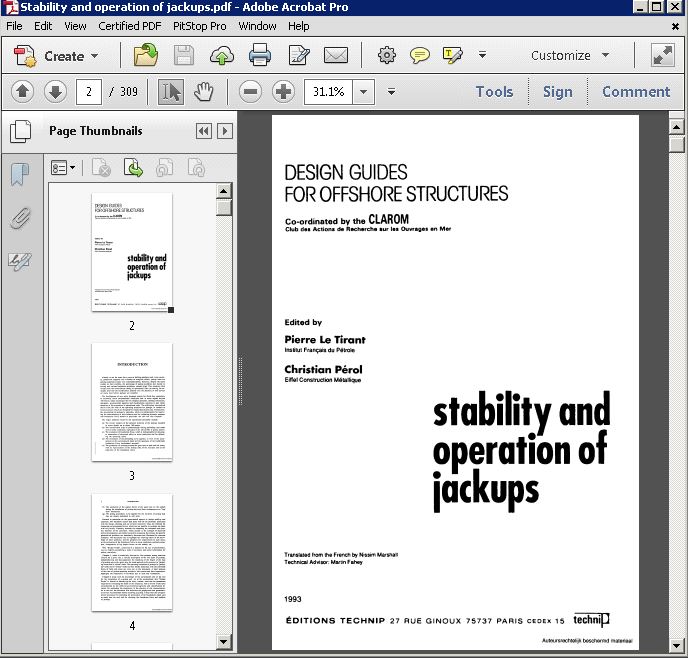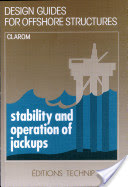Already in use for some forty years as drilling platforms and, more recently, production supports (on a number of marginal fields), jackup units are gaining popularity today over semisubmersibles. However, despite the many studies on their stability, the percentage of jackup accidents, due mainly to towing and various foundation problems, remains high. This situation often results from the inconsiderate taking of operational risks (in towing, for example) and from the insufficiency (indeed even the absence) of soil surveys on many sites before jackups are installed.
The development of new units, designed mainly for North Sea operations, in extremely harsh environmental conditions and in water depths beyond 100 metres, today encourages the oil company operators, drilling contractors, designers, governmental agencies and classification societies to pay closer attention to the prevention of operational risks. The difficulties encountered derive from the wide of the operating situations for jackups, in contrast to fixed structures which are designed for clearly-determined sites. Furthermore, the monitorings of jackups in operation, which are indispensable for improving the understanding of their behavior and for validating dynamic response and foundation fixity models in particular, are still not very frequent.
The major problems faced by the operational personnel include:
(a) The correct analysis of the dynamic behavior of the jackups installed in water depths up to about 100 metres.
(b) The uncontrolled risks of punchthrough during preloading and under severe storm conditions, especially if the soil profile is poorly known.
(c) The evaluation of foundation fixity, which is indispensable for the proper assessment of structural safety in storm conditions and for delimiting the operating zones.
(d) The estimation of the preloading to be applied, in view of the uncertainties in the environmental loads and the ignorance of the mobilizable foundation fixity (embedment moment).
(e) The prediction of scouring around the spud cans in sand and silt zones, with its repercussions on the sliding risks of the structure and on the reduction of the foundation fixity.


چکیده فارسی
واحدهای جک آپ که قبلاً برای حدود چهل سال به عنوان سکوهای حفاری و اخیراً پشتیبان های تولید (در تعدادی از میادین حاشیه ای) استفاده می شوند، امروزه نسبت به نیمه شناورها محبوبیت پیدا می کنند. با این حال، علیرغم مطالعات فراوان در مورد پایداری آنها، درصد تصادفات جک آپ عمدتاً به دلیل بکسل کردن و مشکلات مختلف فونداسیون بالاست. این وضعیت اغلب ناشی از پذیرش بی رویه ریسک های عملیاتی (مثلاً در بکسل) و نارسایی (در واقع حتی عدم وجود) بررسی خاک در بسیاری از سایت ها قبل از نصب جک آپ ها است.
توسعه واحدهای جدید که عمدتاً برای عملیات دریای شمال طراحی شدهاند، در شرایط محیطی بسیار سخت و در اعماق آب بیش از 100 متر، امروزه اپراتورهای شرکت نفت، پیمانکاران حفاری، طراحان، سازمانهای دولتی و موسسات طبقهبندی را تشویق میکند تا توجه بیشتری به پیشگیری داشته باشند. از خطرات عملیاتی بر خلاف ساختارهای ثابتی که برای مکانهای کاملاً مشخص طراحی شدهاند، مشکلاتی که با آن مواجه میشوند ناشی از موقعیتهای عملیاتی گسترده برای جکآپها است. علاوه بر این، نظارت بر جکآپهای در حال کار، که برای بهبود درک رفتار آنها و اعتبارسنجی مدلهای پاسخ دینامیکی و تثبیت فونداسیون بهویژه ضروری است، هنوز خیلی مکرر نیست.
مشکلات عمده ای که پرسنل عملیاتی با آن مواجه هستند عبارتند از:
(الف) تجزیه و تحلیل صحیح رفتار دینامیکی جک آپ های نصب شده در عمق آب تا حدود 100 متر.
(ب) خطرات کنترل نشده ناشی از سوراخ در طول بارگذاری اولیه و در شرایط طوفان شدید، به ویژه اگر مشخصات خاک به خوبی شناخته نشده باشد.
(ج) ارزیابی استحکام پی که برای ارزیابی مناسب ایمنی سازه در شرایط طوفان و تعیین محدوده مناطق عملیاتی ضروری است.
(د) برآورد پیش بارگذاری اعمال شده، با توجه به عدم قطعیت در بارهای محیطی و ناآگاهی از تثبیت شالوده متحرک (لمان جاسازی).
(ه) پیشبینی آبشستگی اطراف قوطیهای اسپود در مناطق ماسهای و سیلت، با پیامدهای آن بر خطرات لغزشی سازه و کاهش استحکام پی.


ادامه ...
بستن ...
Ebook details:
عنوان: Design Guides for Offshore Structures (Collection Patrimoines)
نویسنده: P. Le Tirant
ناشر: Technip Editions (January 1, 1993)
زبان: English
شابک: 2710806363, 978-2710806363
حجم: 7 Mb
فرمت: ُScanned pdf with ocr
ادامه ...
بستن ...












